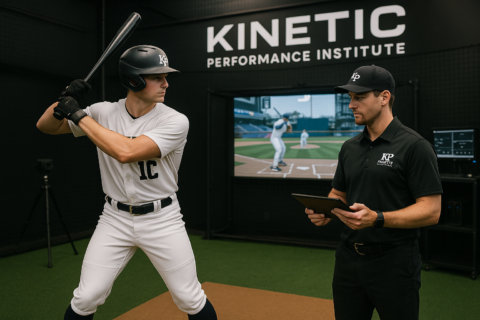Reporting Injuries: How To Create A System to Track Athletes’ Well Being
Reporting, tracking, and treating injuries can be extremely difficult at every level, even college and professional, so being able to establish a system is of the utmost importance. Dealing with injuries with a multi-faceted approach can increase athlete communication, increase awareness by the coaching staff and medical team, and potentially prevent many injuries from getting more serious or even happening at all. At KPI we have developed a great system that is constantly evolving, but is working very well with our population.
There are 3 main facets of developing a system to monitor athlete injuries…
The Athlete
The athlete is at the center of the system, but there are many barriers that often prevent the athlete from communicating about how they are feeling, which can often make the injury worse or something that might be a small issue into a large issue. Athletes generally have 3 main concerns with reporting injuries…
- Toughness – They don’t want to be perceived as not “tough” and don’t want their friends/teammates to make fun of them. So they hold it in and don’t say anything.
- Playing Time Fears – They don’t want to lose playing time so they don’t tell their coach or someone that might tell the coach.
- They Don’t Understand – Often times athletes don’t understand the difference between what they are feeling and how that could be an injury, or potential serious situation. Often times they have a one-track mind and just want to play.
At KPI we have created a system for the athletes that they use daily to communicate with us. They have a daily check-in that allows them to let us know how they are feeling, how much sleep they got, how much stress they are under, and how their arms are feeling (among many things). They also trust giving that information to us because we are not tied to a team and we can give them unbiased information and guidance, without the fear of consequences from a field/team coach.
The Coaching/Training Staff
The coaching and training staff is key in creating and implementing a coherent and cohesive injury monitoring system. We will comment more in the next section on the fundamentals of that system, in this section we will focus on the mindset a staff should take towards the athletes in regarding to injuries.
Training/coaching staffs should have priorities in dealing with and creating systems regarding injuries in young athletes…
- Do What’s Best for the Athletes – This always has to be the #1 priority of any coaching and/or training staff. When dealing with injuries, the staff needs to remove all other outside factors and only focus on what will benefit the athlete the most. This can often be unpopular to an athlete, a family, and a coaching staff, but what’s right is right.
- Clear & Easy Reporting Methods – Many coaches do not have any way for athletes to report how they are feeling and rely on their conversations and observations. The problem with that approach is that it is highly subjective and there are just too many ways an athlete can slip through the cracks. At KPI we have a Daily Check-In embedded into their personal app that they fill out first thing when they get to the facility. They can input their wellness levels and not worry about a coach asking them how they feel and they can feel empowered to objectively state the way their body is feeling
- Knowledge – Having the proper knowledge and perspective is key when building an injury monitoring system. The knowledge aspect is provided by education, certifications, and experience. At KPI we have Masters and Bachelor’s degrees in subjects like Exercise Science and Kinesiology. We also have some of the highest certifications in the field from OnBaseU, Driveline, and Rapsodo. All of this, combined with the proper perspective of athlete well being, allows us to make proper decisions in health and wellness that comes from the viewpoint of knowledge and science.
The KPI System
Our athlete monitoring system has been, and will continue to be, an ever evolving entity, as we constantly look for better ways to improve our system and keep athletes healthy. We are satisfied with our current system, as we have worked very hard to close the loop at our facility. We have created high level systems on the skill and strength sides, so our recent focus has been addressing the wellness side. Here are some of the highlights of the KPI Injury Monitoring System…
- Athlete Self-Reporting – As reported before, we have a Daily Check-In athletes complete each time they come in to train. The check-in gives the athletes the opportunity to let us know how they are feeling and alert us to any potential issues. This is all done through their app and the staff monitors the responses and runs weekly reports on them. We also prioritize building strong relationships with the athletes. This allows the athlete to trust and feel comfortable communicating honestly with the coaching and training staff
- Hawkin Force Plates – Our force plates have quickly become one of the main drivers in our injury monitoring system. The force plates measure many aspects of the Central Nervous System, but we have created a system that allows us to monitor each athlete individually, in the moment, and on a regular basis. We have created a flagging system that notifies athletes to contact a coach if they show a regression in certain parts of their jump profiles. We also do daily and weekly checks on the athletes and refer to each other if a jump profile looks outside of their normal ranges. We communicate constantly on their jump profiles to ensure we are getting ahead of any potential injury situations.
- Slack (Communication Hub) – We use Slack as our communication hub at KPI and have created a channel that is dedicated to only injuries that we update and monitor all day, every day. We share all injuries (big and small) on our Slack channel and we reply to each situation to ensure we follow up on the issue correctly. This allows all coaches to report about an athlete’s well being and every coach can follow up on it. We also use this channel to share progress and post irregularities in jump profiles or physical feelings from the athlete for other coaches to monitor. We also have our facility doctor in this Slack channel to provide input if we need it.
- Partnership with Local Medical Professionals – Our ability to outsource with reputable medical professionals that have open communication has been essential in creating our injury monitoring system. We have recently sponsored with Active Spinal & Sports Care in Morgan Hill to provide premier medical care for the athletes at KPI. Active Spinal is also providing soft tissue work and injury consultations in-house at KPI every Thursday evening. We also refer out and have open working relationships with the best local orthopedics, physical therapists, and massage therapists. Our ability to refer out to the best in the field and have open communication with these professionals has allowed us to close the loop and provide a complete injury system to keep our athletes healthy, training, and on the field.


